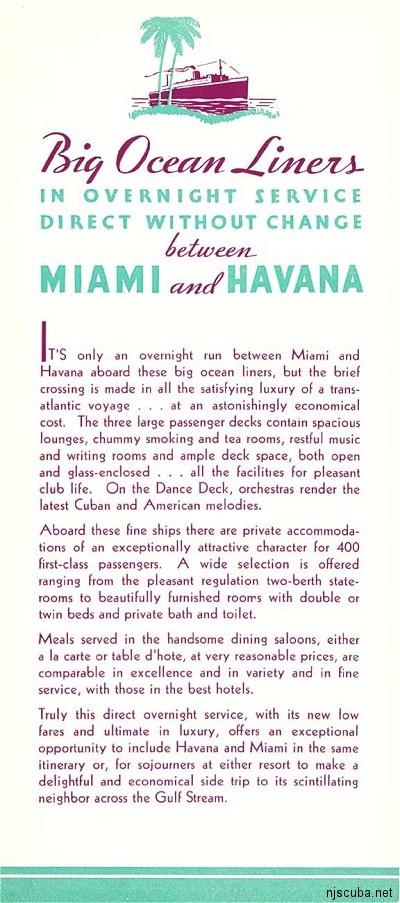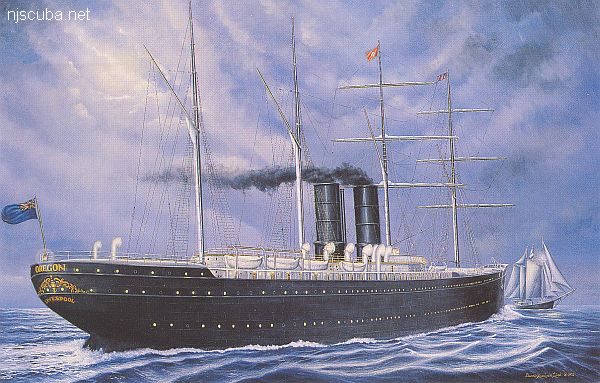Liner

A liner is a vessel designed primarily to carry passengers on a set schedule. There was a time when ocean liners were more than the mere pleasure cruisers of today. Before the advent of modern air travel, ships were the primary means of transport for those needing to cross the oceans. Untold numbers of immigrants came to this country in passenger liners, most in steerage class, a far cry from the modern floating pleasure palaces.
Most passenger liners had a secondary freight-carrying capacity. The Mohawk above has a typical configuration, with a mast and loading boom on the foredeck above a single cargo hatch. She also had side loading doors further aft that even allowed automobiles to drive on and off. The Mohawk had an unrefueled range of 7000 miles at 16 knots, and cost $2,000,000 to construct in 1926. ( $20,790,000 in 2003 dollars. )






The three passenger decks in the superstructure are A-upper (with lifeboats) B-middle, and C-lower. A-deck also appears to have some officer's quarters forward, as well as the Captain's cabin, at the extreme forward end, directly below the bridge. The rest of the crew was probably quartered below, in the hull, which also contained extensive cargo holds with 272,500 cubic feet for freight.
The passenger's entrances on either side of C-deck lead into the "Main Lobby", just aft of amidships. Triple staircases lead up from there to the "Social Hall" on B-deck and the "Sun Parlor" on A-deck. The large dining room is forward on C-deck. The lounge and music room, library and writing room, and glass-enclosed Promenade are forward on B-deck. Most of the other public areas are aft on A-deck, including the "Dancing Deck", "Veranda" and a large "Smoking Room" - a sign of the times. There is also a Barbershop on A-deck. The Ship's Office is off the Main Lobby on C-deck.
The only thing resembling a bar is the "Beverage Room" next to the smoking room - another sign of the times - one must remember that this was during Prohibition. However, there is a large unlabeled space on C-deck adjoining the Dining Room that probably turned into a bar just as soon as the ship cleared US waters ! There was no pool, casino, gymnasium, spa, theatre, playground, roller coaster, or any other of the attractions of a modern cruise ship.
| Deck | Berths * | Men's Toilets * | Women's Toilets * | Baths * |
| A | 30 | 4 | 3 | 1 |
| B | 56 | 8 | 6 | 1 |
| C | 124 | 8 | 6 | 1 |
All rooms had ventilation and hot and cold running water, although there is no mention of air conditioning. 38 rooms had private toilets; 33 of those had private baths. The rest of the passengers had to vie for the rather limited public restrooms and a single public bath on each deck, but this was probably not a great hardship on a day-tripping coastal liner like this. I count total accommodations for 286 persons, double occupancy, with the best suites amidships on C-deck. The aft-most area on C-deck is marked "Steerage, " which probably extends down into the hull for passengers who could not afford a stateroom. The total passenger capacity is given as 446; 585 including crew.
Stateroom cost was each way, on top of the $22.50 round-trip fare, and staterooms ranged in price from $2 for the barest inside cabin to $10 for the best suites with sitting room and full bath. The minimum cost to get your own toilet was $5; bath $6. Adjusted for inflation, that's $302.20 for a round-trip fare, plus $26.86 - $134.31 for a room each way, plus $40.29 Cuban tourist tax. (2003 dollars) Add $402.93 for your car, for a grand total of $1356.53 (plus meals) round-trip for two well-heeled travelers. The distance from Miami to Havana is 228 statute miles or approximately 13 hours at 16 knots. Doesn't seem like such a bargain now, does it?



The United States was once the greatest liner of all - not the biggest, but definitely the fastest. Launched in 1952, 990 feet long, 53,290 tons with a demonstrated speed of 43 knots ( and a true maximum speed probably much greater ) the United States ruled the trans-Atlantic crossing until jet airliners and rising costs finally retired her. Lately, she has been acquired by Norwegian Cruise Lines, and is currently being restored. She may yet sail again.
My mother actually made a crossing on the United States. She said the ship was all stainless steel, glass, aluminum, and plastic inside, very clean and modern and 'American', unlike the rich wood and gilt interiors of older European liners. But what would you expect - the United States was built at government expense as a thinly-disguised troopship, with a surplus battleship powerplant! Her true top speed was deliberately never tested, in order to keep it secret.
Some Liner Specifications:
| Ship | Launched | Dimensions | Tonnage* | Speed* | Fate |
| Oregon | 1881 UK | 518 x 54 | 7,500 | 18 | sunk 1886 |
| Carolina | 1896 USA | 380 x 47 | 5,017 | 15 | sunk 1918 |
| Titanic | 1911 UK | 883 x 92 | 46,328 | 21 | sunk 1912 |
| Mohawk | 1926 USA | 387 x 54 | 5,897 | 16 | sunk 1935 |
| Queen Mary | 1934 UK | 1,019 x 118 | 81,237 | 28.5 | museum |
| Queen Elizabeth | 1938 UK | 987 x 118 | 83,673 | 29 | burned 1972 |
| Andrea Doria | 1951 Italy | 700 x 90 | 29, 083 | 23 | sunk 1956 |
| United States | 1952 USA | 990 x 101 | 53,290 | 43+ | see above |
| Norway | 1960 France | 1,035 x 110 | 66,348 | 35 | in service |
| Queen Elizabeth II | 1967 UK | 963 x 105 | 70,327 | 32.5 | in service |
| Voyager of the Seas | 1999 Finland | 1020 x 158 | 142,000 | 22 | in service |
| Carnival Legend | 2002 Finland | 963 x 106 | 88,500 | 22 | in service |
| Queen Mary II | 2003 France | 1132 x 135 | 150,000 | 30 | in service |
* speeds and tonnages are not directly comparable


- Timetable courtesy of Bjorn Larsson / www.timetableimages.com






